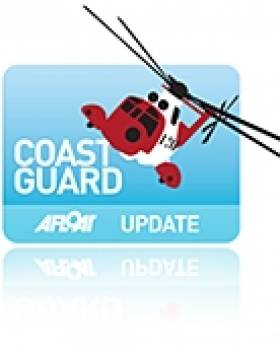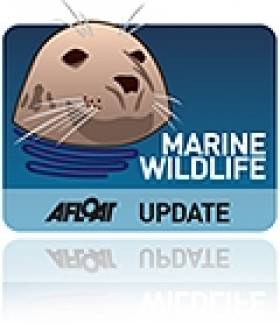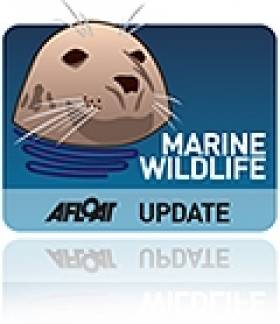Displaying items by tag: Northern Ireland
NI Coastguard Centre May Face Closure
Public spending cuts in the UK could see the closure of Northern Ireland's only coastguard rescue command centre, the News Letter reports.
The coalition government is expected to announce phasing out of a number of the UK's 19 coastguard centres - and a member of the NI Coastguard said that "Bangor is certainly under threat".
The command centre in Bangor oversees coastguard operations along the entire coastline from Lough Foyle to Carlingford Lough, and has handled more than 700 incidents so far in 2010.
The staff member added: "The coastguard here in Northern Ireland is already over-stretched, and we firmly believe that the closure of our centre in Bangor will have a serious and detrimental effect on our ability to respond to emergencies here."
Margaret Elliot - the mother of teenage drowning victim James Elliot, who died in the flood-swollen River Bush in Co Antrim last year – has described the proposed cutbacks as "absolutely disgusting".
"We simply cannot allow this essential service to be threatened in any way. Saving money should never be a factor when it comes to saving lives," she said.
The News Letter has more on the story HERE.
Proposed Irish Sea Conservation Zones
The area include the inshore waters of Merseyside, Lancashire and Cumbria and offshore waters of the Isle of Man, Wales, Northern Ireland and England. One of the zones is a 187 square km stretch of deep water between Northern Ireland and the Isle of Man.
In order to gain a greater understanding of the proposed zones, the report commissioned a Regional Stakeholder Group which drew from a diverse range of interests in the Irish Sea. Among the stakeholders included were the Royal Yachting Association, the fishing community and ports authorities. The review identified the size, shape and locations of the proposed 10 ten new Marine Conservation Zones. For the first time, the zones included inshore water of the Irish Sea project area as well as offshore.
"This is a real milestone for the project, with potential Marine Conservation Zones identified in both inshore and offshore waters", said Greg Whitfield, project manager at Irish Sea Conservation Zones.
"It is now really important that people take a look at the potential zones and give us their feedback on them. The better the information we have, the better the Marine Conservation Zones that are recommended by the regional stakeholder group will be."
Each of the marine conservation zones are designed to protect nationally important marine wildlife, habitats and geology. In addition they are designed to have the least impact possible on people's activities, but some restrictions will apply as the zones must meet guidelines for protecting species and habitats.
Members of the public are being invited to participate and will be considered as the second project continues to refine its proposals. The report is only a snapshot of the work so far. It does not contain concrete recommendations for the locations of Marine Conservation Zones (MCZ) in the Irish Sea, and the potential zones shown in the report are described as tentative and liable to change.
The Irish Sea Conservation Zone project will be releasing a third report before the Regional Stakeholder Group finalises its recommendations. The reports are delivered to the Science Advisory Panel. The independent body is comprised of expert scientists whose main role is to evaluate the potential of MCZs against ecological criteria.
The third progress report will be made available in February 2011. Its final recommendations will then be presented to the UK government in June. Following that a formal public consultation on the proposed MCZs are to take place in late 2011 and early 2012.
For information on the Second Progress Report including feedback forms can be downloaded from HERE or by calling 00 44 (0)1925 813 200
'Propellers' To Blame for NI, Scotland Seal Deaths
Scientists believe that a recent wave of fatal corkscrew-like injuries to seals discovered in Scotland and Northern Ireland are the result of contact with boat propellers.
Original speculation on the ususual injuries pointed the blame at sharks.
But Dr David Thompson, who lead a team of researchers at the University of St Andrews, found that the unique spiralling pattern of the wounds were "entirely consistent with the animals being sucked through large ducted propellers".
More than 30 dead seals - mostly harbour seals - have been found since August 2009, from the Tay and Forth estuaries in Scotland to Strangford Lough.
Researchers believe the incidents may be confined to areas where ships operate in shallow water, but fear they could be more widespread.
Cadets Celebrate 150 Years with Royal Visit
The Cadet Forces in Northern Ireland celebrated their 150th anniversary this year. At a reception to mark the occasion which was held at Hillsborough Castle, Queen Elizabeth II accompanied by the Duke of Edinburgh met the various cadets forces to include the Sea Cadets Corps.
The Sea Cadet Corps are part of the Northern voluntary organisation whose purpose is to develop, in youth, the attributes of leadership,active citizenship and physical fitness within a challenging and fun environment.
In total the organisation has around 3,600 cadets and 500 Cadet Force adult volunteers make up the four cadet forces, including The Sea Cadet Corps, The Army Cadet Force, The Air Training Corps and the Combined Cadet Force whose 1,200 cadets.
The cadets are located at the Bangor Grammar School, CampbellCollege, Foyle and Londonderry College, Royal Belfast Academical Institution and The Royal School Armagh.
.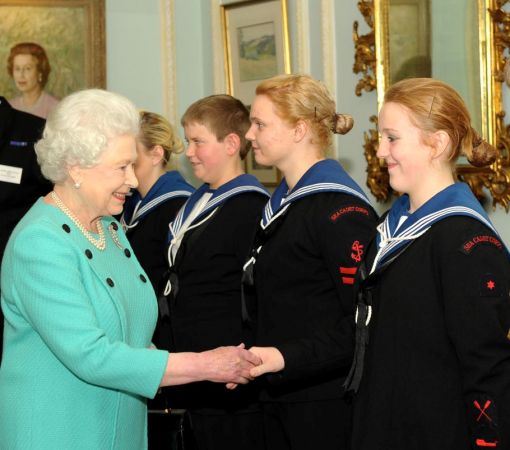
Coleraine Cadet Eimilie Sherman shakes hands with Her Majesty.
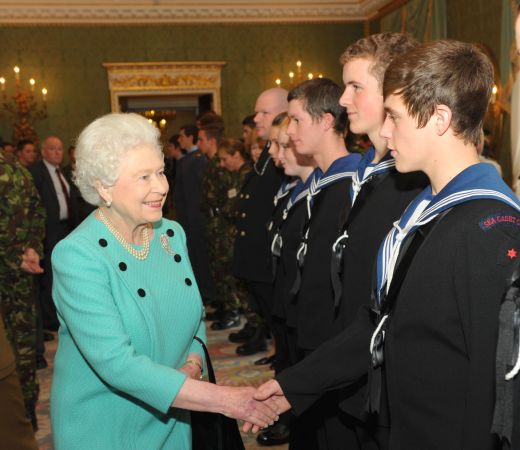
Nick Johnston from Antrim enjoys a chat with Her Majesty.

A moment to treasure for Aaron Brogan
.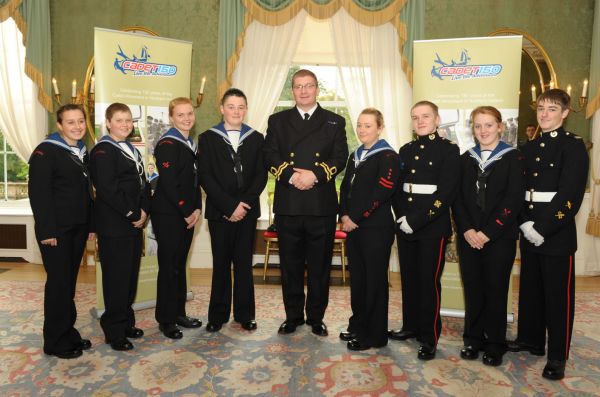
Preparing for the visit are, from left, Rebecca Abram from Larne; Stephen Baird from Ballymena; Andrea Hanna from North Belfast; Luke Douglas from County Down; Lieutenant Robert McLennan from Newtownabbey; Eimilie Sherman from Coleraine; Aaron Brogan from Bushmills; Emma Hobbs from Larne and Ronan Sherman from Coleraine.
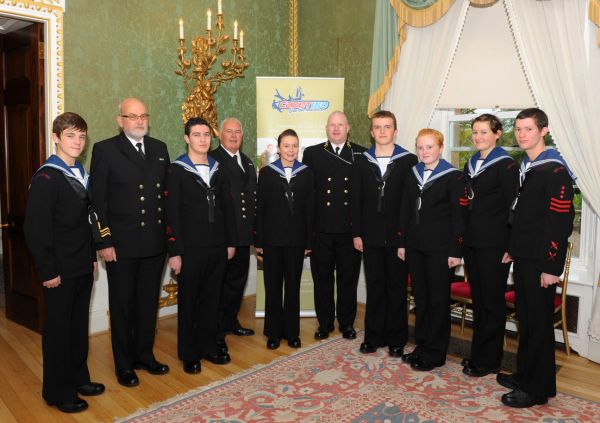
Looking suitably 'ship shape' are, from left, Nick Johnston from Antrim; Lieutenant Commander Ross Mulholland from Glenavy; Johnny McAllister from North Belfast; Lieutenant Commander Bill Keery from Bangor; Alexandra McQuisten from North Belfast; John Kinner from Bangor; Lewis Tipping from North Belfast; Nikita McCoubrey from North Belfast and twins Louise and Thomas Potter from Portaferry.
NI Aquarium Hosts Seal Week
The Exploris Aquarium in Portaferry, Co Down will host its Seal Week from 6-14 November.
The week will feature fun seal-themed events for children and families, including daily seal feedings, as well as talks from the knowledgeable staff who care for the aquarium's rescued seals.
For more on Seal Week activities visit www.exploris.org.uk
Cummins Mercruiser Expands Dealer Network
The appointment is part of CMD's strategy to improve Cummins parts, service and after sales support to the Irish market. GulfStream Marine has a strong engineering focus with a team of mobile engineers and extensive workshop facilities at its premises in Derry. Currently thecompany generates around 50% of its turnover from the provision of engineering services to both the leisure and professional sectors.
Announcing the appointment, a representative of Cummins UK CMD Marine Centre, said: 'A significant amount of new Cummins Mercruiser Diesel product has been delivered into Ireland in recent years and this is set to increase as our market share grows throughout Europe, particularly as we strengthen relationships with OEM boat builders. The recently announced Strategic Alliance between CMD and Volkswagen, also means that from 1st January 2011 the Cummins Mercruiser Diesel dealer network will assume service and warranty responsibility for all engines previously sold under the Volkswagen Marine brand'.
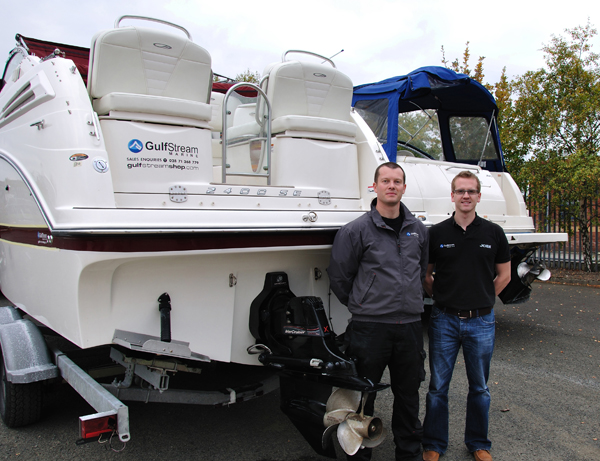
Cummins Technician, Mark Nicholl and GulfStream Marine Managing Director Niall Heaney.
'We are dedicated to ensuring that we have a professional back-up service available in Ireland to support this expanding product range and this is what GulfStream Marine will deliver. We are impressed with their commitment to quality of service and the expertise of their engineering department. We will be working closely together over the coming months and years to ensure that Cummins Mercruiser Diesel customers receive the highest levels of after-sales support'.
Niall Heaney, GulfStream Marine Managing Director, said: "We are delighted to be working with Cummins Mercruiser Diesel. In addition to our Mercruiser petrol inboard and Mercury outboard engine dealerships, this brand rounds out our complete marine engine sales and service offering. With our existing experienced engineering team, our reach for the provision of Cummins Mercruiser Diesel engine sales and support extends throughout the island of Ireland. In today's market customers are seeking convenient service and expert knowledge of the product; this is what we strive to deliver, with all our engineers undertaking continuous training and the ability to carry out service anywhere in the country'.
'We feel that CMD really does stand out from the competition in terms of their dedication to providing the highest levels of dealer support, which in turn means that we can deliver industry leading after-sales care to our customers. Just one example of this is their standard, free of charge, next day delivery service on all stock parts and accessories'. For further information logon to www.gulfstreamshop.com
Warrenpoint Harbour Authority
Warrenpoint Harbour Authority
Warrenpoint Harbour Authority seeks to operate profitably within fair and competitive tariff arrangements so that the Port is economically sustainable. Its aim is to contribute as much as possible to the generation of economic wealth within the Port and its regional hinterland.

Consequently, profit optimisation, to achieve its primary mission rather than profit maximisation, will be pursued.
History
The original Port of Warrenpoint, consisting of a wet dock and piers, was constructed in the late 1770s by Roger Hall, Robert Ross and Isaac Corry with the assistance of £500 of public funds. In 1919 the heirs of Roger Hall sold the Port to John Kelly and Sons for the sum of £16,000. John Kelly continued to operate the Port until 1971 when it was sold to Warrenpoint Harbour Authority for £369,000.
The Port was substantially enlarged with an initial total investment of approximately £6.7million to create the modern Port of Warrenpoint. Until 1971 the Port of Warrenpoint acted as a lightering port for the Port of Newry and jointly these ports handled approximately half a million tonnes of cargo annually. Subsequently the modern Port of Warrenpoint has handled 5 times as much cargo on an annual basis.
Warrenpoint Harbour Authority, The Docks, Warrenpoint, Co. Down, N. Ireland BT34 3JR. Administration/General Enquiries – Tel: 028 417 73381 • Fax: 028 417 52875. Operations – Tel: 028 417 52878 • Fax: 028 417 73962• Email: [email protected]
Port of Larne
Port of Larne
The history of the Port of Larne stretches from the mists of time in the Middle Stone Ages, through the pre-Christian centuries and the Viking raids, to the more modern history of the 19th and 20th centuries and the development of the most modern facilities and technologies which have made Larne a major channel of commercial and passenger traffic in these islands.
It is a story of vision, ingenuity and hard work which turned a small harbour into a thriving Port. Larne developed significantly from the mid-19th century and particularly after the Second World War when the worldwide revolution in unitized traffic and the increased mobility of tourists led to far-reaching technological and other major changes.
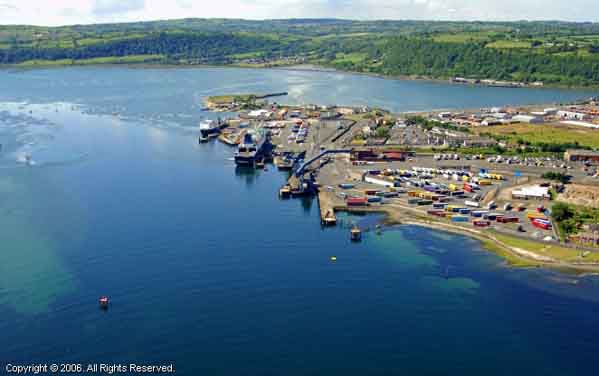
There were years of immense difficulty, including two World Wars, periods of economic depression and times of tragic loss as in the Princess Victoria disaster. However, throughout all these challenges, changes and setbacks, the people of Larne showed remarkable resilience, a determination to learn from the past and to look to the future and a resolve to make Larne the outstanding Port which it is today.
The story of the Port of Larne is also a history of great characters like James Chaine who did most to establish the port in the 19th century, also of Colonel Frank Bustard who in the mid-20th century, had the vision of a new system of moving goods in bulk and who helped to make Larne a most significant part of the container revolution.
Today, Larne is renowned as the premier Port in Ireland. It handles 385, 000 freight units a year, as well as 200,000 tourist vehicles and 750,000 passengers. It is operative 24 hours a day, seven days a week, with up to 30 arrivals and departures daily to and from a number of ports including Troon, Cairnryan and Fleetwood.
History
Larne is believed to have derived its name from Lathar, son of Hugony the Great, High King of Ireland in pre-Christian times who reputedly gave him an area along the Antrim coast roughly from Glenarm to the River Inver which became known in the Gaelic as Latharna. It is recorded that the Roman Emperor Serverus described how, in 204AD a Roman galley bound for Scotland was blown off course to a place called Portus Saxa which was thought to be Larne Lough. The ancient Greeks also had knowledge of the Antrim Coast and Ptolemy, the astronomer and geographer of the 2nd century AD, referred to Islandmagee on one of his maps.
The Viking raiders left their mark and the Lough at one stage was named after a Norse King called Ulfrich. This became anglicised to Wulfrichfjord and eventually Olderfleet which is an integral part of modern Larne. However, while Larne had an undisputed reputation as a good port, the harbour was not being used to its full potential. In the 18th century, there were a number of quays, including the Town Quay which facilitated a lively emigration trade to the United States.
By 1840, the harbour remained underused with only two Larne ships engaged in foreign trade. There was great rivalry between Larne and Donaghdee which had operated a regular service to Portpatrick since 1662. However, this Mail Route was withdrawn by the mid-19th century and the creation of a railway line from Carrickfergus to Larne led to the development of a daily service to Stranraer with a paddlesteamer, the Briton. However, the route did not make profit and the service was withdrawn from 31st December 1863.
In 1866 James Chaine, the son of a prosperous Co Antrim linen merchant bought the harbour with a down payment of £9,000 and changed its fortunes completely. By 1882, Chaine had not only paid off the balance of £10,500 but had also set the Port of Larne on the way to success. He repaired the existing pier and quays and had them extended and developed a rail link to the Port. In 1871 the Larne and Stranraer Steamboat Company was formed and a new paddle steamer the Princess Louise commenced a regular service between the two ports on 1stJuly 1872.
A mail route was established in 1875 and a trans-Atlantic service between Glasgow, Larne and New York began in 1873. Using the renowned State Line vessels, this service continued until December 1889 and many hundreds of emigrants left Larne to start a new life in America.
Sadly James Chaine died from pneumonia in 1885 at the age of 44 and the town and port lost a remarkable visionary. As a mark of respect the people of Larne and district raised funds by public subscription to build the Chaine Memorial Tower which dominates the entrance to the harbour.
20th Century
The Port of Larne continued to prosper in the 20th century. In 1912 the old Larne Harbour Company was replaced by a new company, Larne Harbour Limited, with its new Chairman, Charles MacKean, who remained in office until his death in 1942. In 1914 Larne made the headlines when the largest consignment of arms was landed at the Port during the Ulster Unionists' opposition to Home Rule for Ireland. The crisis was subsumed by the outbreak of the First World War when Larne became a Naval Port where its location rendered it a particularly good anti-submarine base.
The political upheavals after the end of the War and the partition of Ireland had an adverse effect on the Port. This created uncertainty and unrest which led to a sharp decrease in traffic between Scotland and Ireland. There was an attempt to establish a fish-processing business at Larne which ended in failure. By the end of the Thirties, however, the Company was in a better position to expand and the creation of the first proper loading ramps for motorised vehicles gave a hint of what was to come.
Second World War
The Port of Larne played a major role in the Allied Forces efforts during the second World War. More than 5 million people passed through the Port, including 4.3million service personnel. Among these were American troops preparing for the Normandy D-Day landings in 1944. As the War drew to a close and the number of troops and volume of transport decreased, the Port began to return to its pre-war level of activity. However, there was no going back to the past and the challenges, party arising out of the War, were to develop Larne as a major Port in the British Isles.
Post-War
A major figure in the post-war development was Colonel Frank Bustard who was a latter day version of the modern entrepreneur Sir Richard Branson. Bustard's earlier attempt to develop a cheap trans-Atlantic service in opposition to the Cunard Line failed to attract enough backers due to the negative attitude of the government. His ideas were overtaken by the Second World War in which he served with distinction but after the War he developed a brilliant new idea which led to the formation for the profitable freight trade business. This rapidly became the foundation for Larne's rapidly growing success.
Frank Bustard turned his attention to the possibilities offered by converted Naval tank landing ships (LSTs) which had made such a significant contribution to the Allied invasion of Europe. He discovered that these could be adapted to carry cargo driven onboard and in simple form, the RO/RO revolution began. Bustard chartered three LST vehicles and formed the Transport Ferry Service which established a service between Preston and Larne in 1948.
This service began paying its way in 1952 but navigational difficulties at the Preston end and a prolonged strike at the English Port in 1969 spelt the beginning of the end of the Larne-Preston service which ceased in 1973. However a remarkable opportunity had arisen in south-west Scotland where the Atlantic Steam Navigation Company which now owned the Transport Ferry Service purchased the then virtually unknown port of Cairnryan.
This port had been built during the Second World War to load ammunition ships for overseas service. It was sold in the Sixties to ASN for the then princely sum of £25,000. However, it was not until 10th July 1973 that the new ASN Larne-Cairnryan service was inaugurated, thus giving Larne access to the shortest crossing on the Irish Sea which it remains to this day. This was to have significant effect on the success of the Port of Larne. Colonel Frank Bustard deservedly was made a Freeman of Larne for his efforts.
Key Developments
The decades from the Fifties to the Seventies witnessed key developments at Larne.
Throughout these decades, with the rapid growth of containerised traffic, the Port became a major link across the Irish Sea. There was a proliferation of loading facilities and new quays, including the extension of the Olderfleet Quay, the construction of the Phoenix and Curran Quays, with the inclusion of Mulberry Harbours from the Second World War and the completion of Castle Quay. Increased facilities meant more sailings and passengers and in 1967 the Mail Quay Passenger Terminal was officially opened.
From the sixties onwards, the Port of Larne developed the Redlands estate at the harbour. Alongside this area, the infrastructure to carry out a new dual carriageway to the Port was developed thus bypassing the town and also to cater for the vastly increased volume of freight and passenger traffic using the harbour.
Passenger and Freight Services
Following the establishment of the new route between Larne and Cairnryan, the holding company Transport Ferry Services was bought by European Ferries which owned Townsend-Thoresen. The take-over by the European Ferries Group intensified the modernisation of the Port and the expansion of facilities continued apace.
The Chaine Quay, named after James Chaine who had put Larne on the map as a port in the 19th century was re-developed and formally opened on 27th June 1978 in the presence of the then Chairman, Major George B. MacKean, the son of the first Chairman of Larne Harbour Ltd, Charles MacKean. Almost a year later, the Continental Quay was officially re-opened. Both these quays provided a double-deck ramp, the first in Ireland, and were installed to cater for the simultaneous working of both decks of the new vessels which were coming into operation on the Irish Sea at that time.
While the passenger and freight service between Larne and Cairnryan grew in popularity, a similar service between Larne and Stranraer which had operated for many years as a Mail Route, also continued to prosper. Tragically, however, the Princess Victoria foundered in heavy seas off the Irish coast on 31st January 1953 with the loss of 133 lives including 27 inhabitants of Larne.
Over the years a series of modern vessels maintained the service on the Larne-Stranraer route including the Caledonian Princess, the Antrim Princess and the Galloway Princess, all of which were seafaring showpieces in their time and which operated under various flags. The closure of the Belfast-Heysham service 1n 1975 generated even more business for the Larne routes to Cairnryan and Stranraer. The freight services continued to be profitable and in addition to the existing routes, new services were established. These included the Larne to Ardrossan route under different operators from 1956 to 1976 and more recently under P&O from 1992 until its relocation to Troon in 2001.
Fleetwood Service
The Larne to Fleetwood Roll On/Roll Off service, operated by Pandoro began in 1975 replacing an earlier LO/LO service operated by P&O Ferrymasters since 1973. This service was particularly popular with hauliers who wanted direct access to North-West England and especially to the motorways near Fleetwood and Liverpool. In the early days, Pandoro operated one ship daily to Fleetwood and another to Liverpool until 2002 when a daily Larne-Liverpool freight service commenced. As part of the service, the vessels provided good cabin accommodation and a free hot and cold buffet.
In 1999 a third vessel was provided for the Fleetwood route to meet the demand from hauliers and also an increasing number of motorists who wanted direct access to the Lancashire coast and the M6 motorway. Early in the year 2000, this RO/RO service celebrated its 25th anniversary which was a testimony to its stability and progress through decades of change in the ferry business.
P&O
In 1986, European Ferries was taken over by P&O and as the new Millennium approached, the last years of the 20th century brought accelerated progress at Larne. Significant improvements were made at the Port. The Mail Quay was totally redeveloped and later renamed the MacKean Quay in honour of the family's long and distinguished association with Larne Harbour Ltd. Construction on the £3.5m scheme which included a two-tier ramp, was partly assisted by the European Regional Fund (ERDF) and the Government Port Modernisation Grants. Over the years ERDF made a major contribution to the development of modern facilities at the Port.
The Quay was formally opened in 1987 by Mrs Patricia MacKean, widow of the former Chairman Major George MacKean. The modernisation of the Port continued and in 1993 the refurbished Curran Quay was formally opened by Gavin Hastings, the Scottish Rugby international and captain of the British Lions.
In 1996 a 2m high-technology Distribution Centre for the storage of fresh and chilled produce was opened on Redlands Estate which had been developed over the years by Larne Harbour Ltd. The opening of a Freight Centre in 1998 enabled drivers to have their vehicles weighed, checked-in and marshalled in a single, smooth and fast operation a good example of the Port identifying customers' needs ahead of demand.
As a further enhancement of the Port's facilities, the Board of Larne Harbour Ltd had been aware for many years of the need to improve the road links on both sides of the channel. This had some effect but much remained to be done. In May 1998 the Government announced a new £10m scheme to improve the approach road to Larne. The construction by Phoenix Gas of a £7m gas pipeline across the Lough and through the Company's land gave local customers a wider choice of energy sources.
The New Millennium
By the beginning of the new Millennium, the Port of Larne was among the busiest on the Irish Sea. The RO/RO facilities dealt with a wide variety of shipping including the most modern high-speed ferries and the port also had the capacity to handle a large range of bulk and general cargo.
At the Port of Cairnryan, splendid new terminal facilities costing £4.5m was opened in April 1999. These included separate reception areas for tourist and freight traffic, new booking and information offices, a baggage-handling area and facilities for children and the disabled.
Though there was steady progress throughout the late Eighties and early Nineties, the shipping company Stena Sealink announced in 1995, its intention to leave Larne and to establish a new route from Belfast to Stranraer. Inevitably there was a downturn in business at Larne but the people and the Port rose to the challenge and by the early years of the new millennium, the number of tourists and commercial vehicles had increased steadily.
The continued commercial confidence at Larne was underlined by significant additions to the shipping fleet. In February 1999, P&O announced an order for European Causeway, a new 21,000 tonne passenger and freight ferry from Mitsubishi of Japan, which came into service in August 2000. The luxurious new vessel with a top speed of 23 knots was designed to reduce the travelling time on the conventional ferry to Cairnryan to just 105 minutes a reduction of 25% on the time taken by the older vessels. A sister ship European Highlander with similarly luxurious facilities and high technology features went into service in July 2002.
The competitive edge to modern ferry travel from Larne had been sharpened some three years earlier with the introduction of the powerful P&O Jetliner, a high-speed ferry with an operating speed of 32 knots. This reduced the Larne-Cairnryan crossing to just one hour, the fastest on the Irish Sea. In Spring 2000, the Jetliner was superseded by the larger and more luxurious Superstar Express.
For the further convenience of passengers, a Call Centre was opened in 1998. Overall the Port of Larne moved into the new Millennium on a sound commercial footing and this was in no small measure due to its strength in depth as part of the P&O Group.
The Port of Larne has developed dramatically since it's origin in the mists of time. It had risen to the commercial challenges of succeeding centuries, survived the trauma of two World Wars and positioned itself to take advantage of the latest technological developments in the world of shipping and freight to gain a deserved reputation as the premier Port in Ireland.
Now in the early years of the third Millennium, it is well placed to continue its momentum as a top-class facility and to keep faith not only with its passengers and freight customers but with all those down the years who worked hard to make the Port of Larne what it is today.
This history is provided by Alf McCreary.
The definitive history of the Port of Larne is contained in the hard-back book by Alf McCreary title, A Vintage Port – Larne and it's People. Published by Greystone, it is priced at £14.95 and is available from all good bookshops and also on Larne ferries.
Port of Larne, 9 Olderfleet Road, Larne, Northern Ireland BT40 1AS. Tel: 028 2887 2100 • Fax: 028 2887 2209 • Email: [email protected]
Port of Belfast
Port of Belfast
The Port of Belfast is Northern Ireland's principal maritime gateway, serving the Northern Ireland economy and increasingly that of the Republic of Ireland. About 60% of Northern Ireland's seaborne trade and 20% of the entire island's is handled by the Port which receives over 6,000 vessels each year.
The Port is also a major centre of industry and commerce - its Harbour Estate is home to some of Northern Ireland's most important urban regeneration projects and it is the region's leading logistics and distribution hub.
With 1.2 million passengers and half a million freight units annually, Belfast is Ireland's busiest ferry port. It is also the island's leading dry bulk port, dominating the market with regard to imports of grain and animal feeds, coal, fertilisers and cement, and exports of scrap and aggregates. Over 95% of Northern Ireland's petroleum and oil products are also handled at the Port.
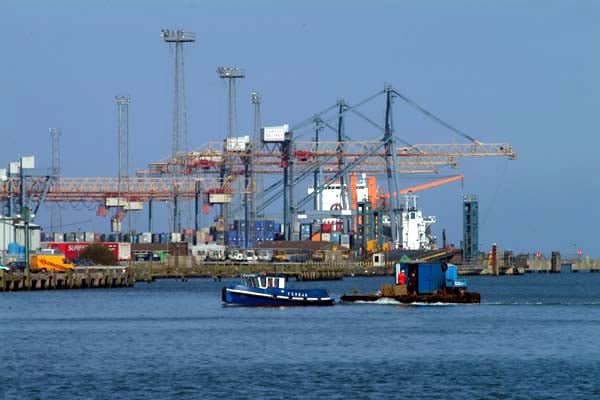
History of the Port
The origins of the port in Belfast can be traced back to 1613, when, during the reign of James I, the town was incorporated as a borough by royal charter, with provision for the establishment of a wharf or quay. As a result, a quay was constructed at the confluence of the Rivers Fearset (Farset) and Lagan and the development of the Port of Belfast began.
Records show that by 1663 there were 29 vessels owned in the town with a total tonnage of 1,100 tonnes. Trade continued to expand throughout the century, to the extent that the original quay was enlarged, to accommodate the increasing number of ships.
By the early eighteenth century the town had replaced Carrickfergus as the most important port in Ulster and additional accommodation was considered necessary. A number of privately-owned wharves were subsequently constructed on reclaimed land. Throughout the century trade continued to expand as Belfast assumed a greater role in the trading activities of the country as a whole. In 1785 the Irish Parliament passed an act to deal with the town’s burgeoning port. As a result, a new body was constituted: The Corporation for Preserving and Improving the Port and Harbour of Belfast, commonly called “the Ballast Board”.
Although at this point the Port was well established it remained disadvantaged by the natural restrictions of shallow water, bends in the channel approach and inadequate quays. These problems, together with an increasing volume of trade, led to a new government act of 1837. This reconstituted the Board and gave it powers to improve the port, through the formation of a new channel. Initial work on straightening the river commenced in 1839 and by 1841 the first bend had been eliminated. The creation of what was to become the Victoria Channel had begun.
In 1847 the Belfast Harbour Act repealed previous acts and led to the formation of the Belfast Harbour Commissioners. This new body, with much wider powers, completed the second stage of the new channel two years later. From that time the Commissioners have developed and improved the Port, reclaiming land to accommodate new quays, new trades and changes in shipping and cargo-handling technology. The efficient, modern port of today is evidence of the foresight and commitment of successive generations of Harbour Commissioners.
Port of Belfast, Harbour Office, Corporation Square, Belfast, Northern Ireland BT1 3AL. Tel: 028 9055 4422
Commercial Contacts – Email: [email protected] • Tel: 028 9055 4422 • Fax: 028 9055 4420
Marine Contacts – Email: [email protected] • Tel: 028 9055 4422 • Fax: 028 9055 3017
Estate Contacts – Email: [email protected] • Tel: 028 9055 4422 • Fax: 028 9055 4411
Corporate Contacts – Email: [email protected] • Tel: 028 9055 4422 • Fax: 028 9055 4420
Human Resources – Email: [email protected] • Tel: 028 9055 4422 • Fax: 028 9055 4420
Harbour Police – Email: [email protected] • Tel: 028 9055 3000 • Fax: 028 9055 3001
Harbour Safety – Email: [email protected] • Tel: 028 9055 4422 • Fax: 028 9055 3020
Calls within the Belfast Harbour Police telephone system may be monitored or recorded
North West Personal Watercraft Club
North West Personal Watercraft Club
Our club was initially set up to save PWC users from being banned from a local lake. Now that we’ve successfully saved our lake we want to grow our club by increasing its members and arranging days out.
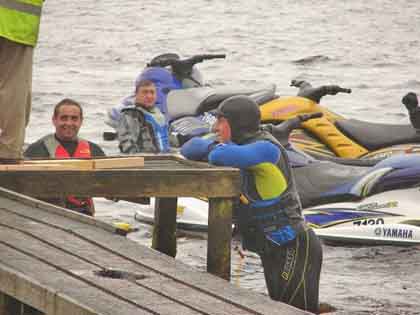 Pictures from the Fun Day, 6th September, 2009
Pictures from the Fun Day, 6th September, 2009
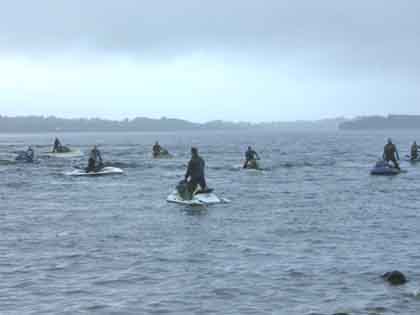
We are a growing group of friendly, likeminded people that just want to have fun and be safe on a variety of personal privately owned watercrafts including boats, jetskis and standups.
The NWPWC website is a base for all things related to our club so please take some time to have a look around and feel free to get in contact and discuss becoming a member if you like what you see.
Our club is based in the North West of Ireland with committee and members from both sides of the border.
North West Personal Watercraft Club, 191 Melmount Road, Sion Mills, Co Tyrone BT82 9LA, N. Ireland. Email: [email protected]
or c/o Yel McClintock, Balliscadden, Coolboy, Letterkenny, Co Donegal. Fax: 0044 288 165 9111
Have we got your club details? Click here to get involved



























